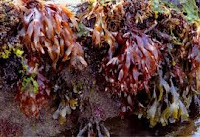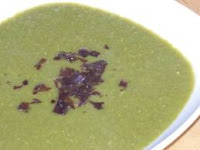Monk’s rhubarb, or Patience dock, herb patience or common garden patience, is a member of the Polygonaceae family of plants. It is closely related to Yellow dock, common dock and red dock or bloodwort, arrowleaf dock or Khatti buti, sorrel and wood sorrel. As a member of the Polygonaceae family it is related to water pepper (hot arssmart), bistort, Lady’s Thumb, water smartweed and buckwheat.
Monk’s rhubarb is native to continental Europe but has naturalized in some parts of Britain.
 This dock is eaten as a leafy green vegetable in Eastern Europe, as spinach is. You can eat it cooked or raw, but as this genus is known to contain oxalic acid, it is better to have it cooked as cooking reduces the amount of acid in the plant. It can be used as a salad green, although it is best to mix it with other green leaves such as sorrel for a better flavour, and it can be cooked and pureed. The plant flowers in June and July with its seeds ripening in August. The young leaves appear early in the year and are best eaten at this time. Monk’s rhubarb can grow to heights of around five feet and has a spread of around 18 inches.
This dock is eaten as a leafy green vegetable in Eastern Europe, as spinach is. You can eat it cooked or raw, but as this genus is known to contain oxalic acid, it is better to have it cooked as cooking reduces the amount of acid in the plant. It can be used as a salad green, although it is best to mix it with other green leaves such as sorrel for a better flavour, and it can be cooked and pureed. The plant flowers in June and July with its seeds ripening in August. The young leaves appear early in the year and are best eaten at this time. Monk’s rhubarb can grow to heights of around five feet and has a spread of around 18 inches. The root of the plant and leaves have antioxidant properties and the root has a little effect on the symptoms of diabetes. Dye may also be obtained from the roots.
An infusion of the root has been used in traditional systems of medicine to relieve constipation and the juice of the plant in the root infusion is used for skin problems. The leaves, rubbed in the mouth are said to afford some relief from sore throats.
“A dram of the dried root of Monk's Rhubarb with a scruple of Ginger made into powder, and taken fasting in a draught or mess of warm broth, purges choler and phlegm downwards very gently and safely without danger.... The distilled water thereof is very profitably used to heal scabs; also foul ulcerous sores, and to allay the inflammation of them....”
 He also says “This is a Dock bearing the name of rhubarb for some purging quality therein, … and points out this is not a wild dock, but a cultivated one in Britain. That being so, he says this about docks in general:-
He also says “This is a Dock bearing the name of rhubarb for some purging quality therein, … and points out this is not a wild dock, but a cultivated one in Britain. That being so, he says this about docks in general:- "Government and virtues. All docks are under Jupiter, of which the red dock, which is commonly called blood-wort, cleanseth the blood, and strengthens the liver; but the yellow dock-root is best to be taken when either the blood or liver is affected by choler. All of them have a kind of cooling (but not all alike) drying quality, the sorrel being most cold, and the bloodworts most drying. ... The seed of most of the other kinds, whether the gardens or fields, do stay lasks and fluxes of all sorts, the loathing of the stomach through choler, and is helpful for those that spit blood. The roots boiled in vinegar helpeth the itch, scabs, and breaking out of the skin, if it be bathed therewith. The distilled water of the herb and roots have the same virtue, and cleanseth the skin from freckles, morphew, and all other spots and discolourings therein.
 All docks being boiled with meat, make it boil the sooner; besides, blood-wort is exceeding strengthening to the liver, and procures good blood, being as wholesome a pot-herb as any that groweth in a garden; yet such is the nicety of our times, forsooth, that women will not put it into a pot, because it makes the pottage black; pride and ignorance (a couple of monsters in the creation) preferring nicety before health."
All docks being boiled with meat, make it boil the sooner; besides, blood-wort is exceeding strengthening to the liver, and procures good blood, being as wholesome a pot-herb as any that groweth in a garden; yet such is the nicety of our times, forsooth, that women will not put it into a pot, because it makes the pottage black; pride and ignorance (a couple of monsters in the creation) preferring nicety before health."I particularly like his social commentary!
















